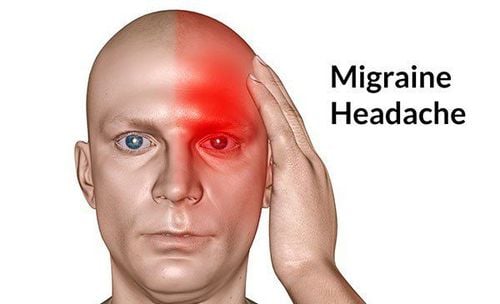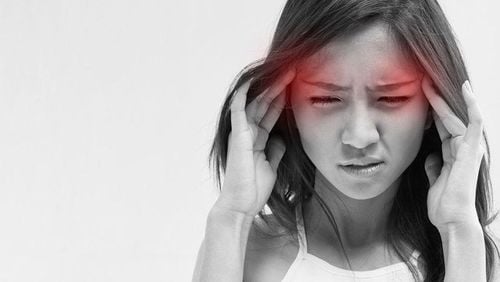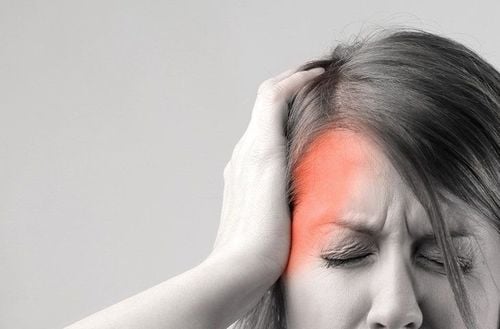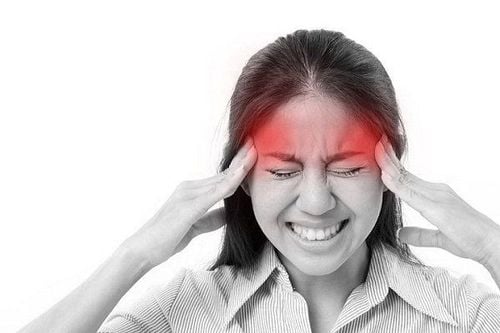This is an automatically translated article.
Consulted by BSCK II Pham Thi Son - Neurologist - Department of Medical Examination & Internal Medicine, Vinmec Hai Phong General HospitalDifferent types of headaches will present with different symptoms, potentially causing blurred vision, throbbing, dull, sometimes intense, lasting from a few minutes to a few days. Differentiate the types of headaches so that they can be effectively treated and prevented.
The following are classifications of headaches according to the 2004 International Headache Society (HIS) classification.
1. Migraine Migraine
Migraine is one of the dangerous types of headaches, causing pain on one side of the head in waves, often accompanied by vomiting. The prevalence of this type of headache is 12% of the population. More than 75% of migraine sufferers will have someone in their family also. It usually begins in adolescence and rarely appears after the age of 60. Patient age is usually between 20 and 50 years old.Characteristic of the disease symptoms is pain in one half of the head, the patient feels in the head like a string that is constantly jerking with the pulse. On the other hand, the pain has the ability to rotate, from one side of the head to the other. The pain usually varies in intensity from mild, with only a fleeting sign of pain, to severe pain that can last from hours to days. Pain symptoms often occur suddenly or with warning with signs such as: dizziness, loss of vision, dizziness, ringing in the ears, double vision, difficulty speaking, numbness of the scalp. The pain tends to get worse when the person moves, moves, coughs, sneezes, or changes the position of the head.
Migraine has many different types:
Common Migraine Classic Migraine Ocular Migraine Retinal Migraine Cyclical Syndromes in Children Complications of Migraine Migraine Migraine does not meet the above criteria

2. Tension headaches
In the classification of headaches, tension headaches are ranked among the most common today. Tension headaches can appear temporarily, sometimes continuously every day and last from 30 minutes to a few days with the nature of a severe headache like a pressure, feeling like something is tied to the head. The intensity and severity of pain usually ranges from mild to moderate, can be pain in the scalp, temples or pain in the back of the neck. Patients often have pain on both sides of the head or sometimes radiating throughout the head. However, the pain usually does not increase significantly with light physical activity or climbing stairs.Among the types of headaches, the tension type can be considered to have a subjective cause, mainly due to lifestyle. This condition is usually caused by a muscle response to stress, depression, a head injury, or anxiety. This pathology occurs most commonly in adults and young people, people who work in corporate offices, people who have a habit of focusing on the computer screen for too long, working too hard...
Headache Tension headaches include:
Cyclical tension headaches Chronic tension headaches Tension headaches do not meet the criteria above.

3. Cluster headaches and chronic migraines
Cluster headaches are common in men (accounting for about 80%), especially men between 20 and 40 years old. This group of subjects also often presents with chronic migraine attacks. The pain is most common in each area of the face, usually concentrated in the eye sockets, then radiates to the forehead, temples, cheekbones and nose wings. Pain may also appear in the nasopharynx, jawbone or neck area.Headaches of this type are often distinguished from other types of headaches by the manifestation of becoming severe and rapidly reaching a peak after 10 minutes, sharp pain, pain that does not get stronger when the patient moves, accompanied by some symptoms. eye or nose problems. Eye symptoms include: lacrimation, conjunctival congestion, ptosis, and pupillary constriction. Nasal symptoms include: a stuffy or runny nose. In addition, patients may experience additional signs of face sweating, flushed skin in the eye or forehead area. Symptoms are usually divided into the following groups:
Cluster headaches Chronic migraines Headaches that resemble cluster headaches do not meet the above criteria.
4. Other headaches not due to structural damage
This type has many different types, including:Primary stabbing headache Extracranial compression headache Cold headache Benign cough headache Benign exercise headache Headache associated with childbirth sexual activity.
5. Headache after traumatic brain injury
Every day, the whole country records many cases of traumatic brain injury due to various causes: traffic accidents, construction workers falling due to scaffolding collapse, children suddenly falling from mezzanines, elderly people slipping. In the bathroom, the assault subjects hit each other on the head. After such incidents, the patient needs to pay close attention to the headache symptom, because this is one of the dangerous types of headache.Symptoms of headache appear along with vomiting, seizures or change in consciousness, causing drowsiness, lethargy and even coma, accompanied by weakness in the limbs. These are signs of an intracranial hematoma, which requires emergency diagnosis and treatment in a hospital. Headache after traumatic brain injury is divided into two types due to the nature of symptoms:
Acute post-traumatic headache Chronic post-traumatic headache
6. Headache accompanied by vascular diseases
Blood and blood vessels are important components, playing a vital role in the body. When there are the following abnormalities with blood vessels, the patient's body will signal headache symptoms:Acute cerebral ischemia. Hematoma in the skull. Subarachnoid hemorrhage. Unruptured cerebrovascular malformation. Arteritis. Carotid or vertebral artery pain. Venous thrombosis occurs. Arterial hypertension. Headache associated with other vascular diseases.

7. Headache accompanied by non-vascular intracranial disease
This group of headaches is associated with the following conditions:
Increased CSF pressure. Reduce cerebrospinal fluid pressure. Intracranial infections. Sarcoidosis and other intracranial aseptic inflammatory diseases. Headache associated with injection into the cerebrospinal fluid space. Intracranial tumor. Headache associated with other intracranial disease.
8. Chemical headaches
The effects of chemicals on the body include causing headaches. This condition can be acute or chronic depending on the concentration and duration of exposure, divided into the following subtypes:Acute chemical exposure or use headache or chronic exposure to chemicals Chemical discontinuation headache (acute) Chemical discontinuation headache (chronic) Chemical-related headache but undetermined mechanism.

9. Headache accompanied by extra-cerebral infections
This includes:Viral infections Bacterial infections Headaches associated with other infectious diseases.
10. Headaches due to metabolic disorders
About 19% of our population is suffering from metabolic syndrome. Metabolic headache is one of the dangerous types of headache with causes such as:
Hypoxia Increased CO2 pressure in the blood O2 deficiency and mixed CO2 hypertension Hypoglycemia Problems in dialysis Headaches associated with other metabolic disorders
11. Headache or facial pain associated with diseases of the skull, nape, eyes, ears, nose, sinuses, teeth, mouth or other cranial or facial structures
This headache occurs in the following parts:
Skull, neck, neck, eyes, ears, nose and sinuses Teeth, jaw and related structures Temporomandibular joint disease.
12. Headaches due to cranial nerve pain, nerve trunk and loss of centrifugal conduction
Classification of this headache is based on the causes:
Persistent pain in the cranial nerves Trigeminal neuralgia Pain in the lingual-pharyngeal nerve Pain in the VII minor nerve Pain superior pharyngeal neuralgia Sciatica occipital nerve Central cause of facial headache and TIC Facial pain does not meet the criteria in groups 11 or 12.
13. Headache not classified in the above groups
In short, there are many dangerous types of headaches. To differentiate between different types of headache, patients may need intervention from many different specialties. Choosing a reputable headache clinic, patients will feel more secure in their treatment. Vinmec Hai Phong International General Hospital is a top quality medical facility with many advantages:Medical team Skilled and experienced doctors, with the connection support of the entire Vinmec system up to JCI international standards. State-of-the-art equipment: Being the first hospital in Hai Phong to own a 640-slice Aquilion One (Vision Edition) Post-traumatic Headache Machine from Signa Pioneer 3.0 Tesla of GE (USA) and a CT scanner Aquilion One (Vision Edition) of Toshiba (Japan), along with the most accurate and early diagnosis of vascular and nerve damage. Currently, in Hai Phong, only Vinmec hospital has a video EEG machine, which is of high value in accurately diagnosing epilepsy. Executing doctor: Doctor CKII Pham Thi Son - with 20 years of experience in the field of neurology. In particular, the doctor has a lot of experience in diagnosing and treating headaches.

Please dial HOTLINE for more information or register for an appointment HERE. Download MyVinmec app to make appointments faster and to manage your bookings easily.














